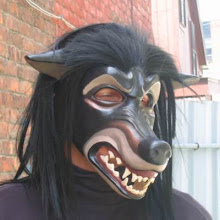
This is my first attempt at "Chiesatine" paper mache, otherwise informally known as cotton-fluff paper mache, fresh and raw from the mold. I owe a huge thank-you to Mathieu Rene, a maskmaker based in Montreal, for emailing back and forth with me about how to do this. (His blogs: www.maskmaking.blogspot.com and www.creaturiste.blogspot.com.)
I have avoided trying the more traditional paper-strip-and-glue methods of paper mache as I didn't think they could pick up the fine detail (gumlines, wrinkles, etc) in my masks. I also felt they would probably be too time consuming for someone who already sinks 20+ hours into each mask. But then I was having trouble finding a material strong enough for the "eyeball" mask shown above- those fragile eyebrows would break as soon as I dropped the mask, no matter what it was made of- so I thought I would give this method a try.
I have to say, I am very, very, very, very impressed- and I mean VERY IMPRESSED- with how strong this mask is. Trimming it was next to impossible. As in, the Exacto knife couldn't touch it. As in, the Dremel could hardly touch it. As in, I had to keep turning up the motor speed, and changing the bits, and turning off the Dremel so that the mask could cool down and not catch fire, etc. Mathieu has told me that I didn't need to use as strong a glue as I did (Weldbond, a kind of white glue on steroids) so for my next attempt I'm going to try some version of Elmer's. But in any case, this mask can survive being dropped on the floor!
I am also very pleased with the detail in the cast. The fluff really did pick up all the little lines and edges quite well. The cast was also very true- no pinholes, blisters, cracks, etc, so unlike the Paperclay casts it required next to nothing in the way of repair. So while this method *was* quite time-consuming, I'm thinking it may take no more time than the Paperclay method, and it will yield a superior mask. I may even come out ahead since the materials are so incredibly cheap.
So very briefly, here's how I did this. First I applied a layer of absorbent cotton, purchased in a roll in a medical supply store, into the mold. I pressed it in firmly with a wet brush, removed as much water as I could with a sponge, and then painted in a layer of diluted glue. After that layer had dried, I applied a layer of cheesecloth, coated that with a layer of diluted glue, and then after THAT layer had dried I applied two layers of torn Kraft paper and coated those with the diluted glue.
I have yet to try this in a large multi-part mold. The big molds do sometimes seem to follow different laws of nature than the smaller ones. We'll see what happens!



1 comment:
Hi Carrie. Creaturiste here.
The term is actually "Chiesatine", in honor of the family name (Chiesa) of the Italian maskmaker who developped the method originally, says the French maskmaker who thought me the method. She also said it had been meant to imitate leather masks (in looks only, I think).
Good work on your masks, they look amazing!
Post a Comment